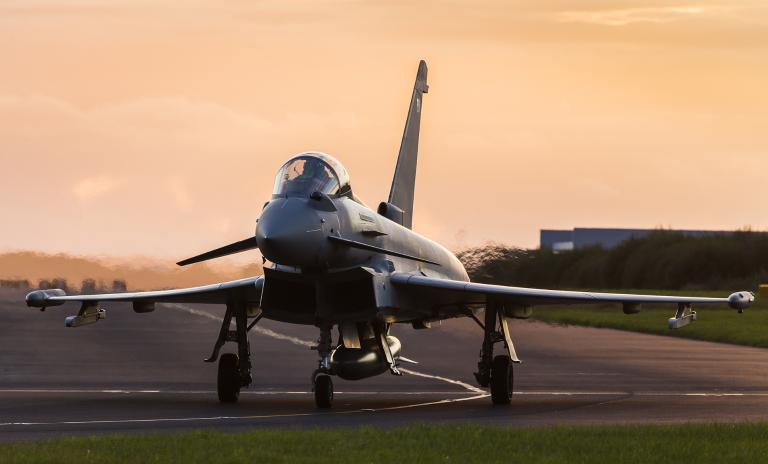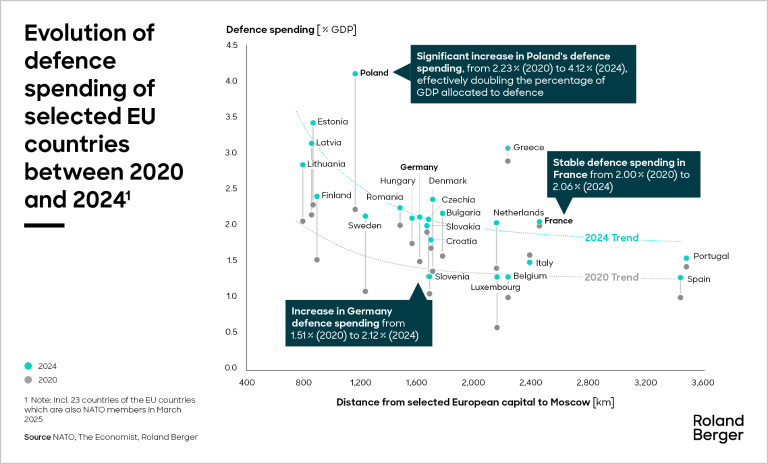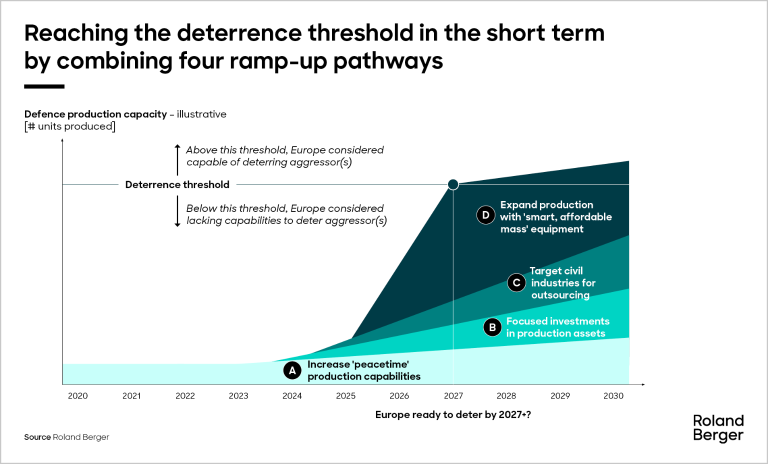Discover how sector-specific ESG ratings can enhance A&D performance. Learn from RB’s tailored approach and industry insights to improve sustainability and operational efficiency.


From sleeping giant to defence superpower
Europe’s path to sustainable deterrence in a changing security landscape
Europe finds itself in an environment of existential threat. Although the continent’s defence budgets are on the rise, achieving sustainable deterrence requires more than financial resources – it demands a holistic approach suited to evolving warfare paradigms. In a new report, Roland Berger examines how Europe can ramp up industrial capacity and spur innovation, highlighting priority areas for both public and private actors.

"As we enter a ‘new world’, civil innovators can help defence firms to stay agile and cost-effective."
Since Russia's annexation of Crimea in 2014 and its wider invasion of Ukraine in 2022, Europe faces its greatest security crisis since World War 2. Meanwhile, a weakened transatlantic alliance has pushed Europe to reassess its defence posture, driving major investments and ambitious plans at both national and international levels.
Germany’s new government, for instance, has secured approval for a debt-funded defence investment package, while France is exploring a defence budget of up to 5% of GDP and the United Kingdom aims to reach 2.5% of GDP by 2027. The European Commission’s ‘ReArm Europe Plan/Readiness 2030’ could also potentially mobilise up to EUR 800 billion.

The current state of European defence
In terms of troop strength and operational platforms, Europe (27 EU members, plus the United Kingdom) remains a considerable force when compared to Russia and the world’s two largest military powers, China and the United States. Nevertheless, we believe Europe must improve in seven overarching areas to enhance its deterrence capabilities. Addressing these areas will be critical to ensure the continent’s security, autonomy and preparedness. They are:
- European defence cooperation
- Investment in innovation and R&D
- Industrial scale and capacity
- Troop numbers
- Adapting to the evolution of warfare
- Access to strategic enablers
- Societal resilience
Facing a wide spectrum of threats
Warfare is changing quickly. Europe today faces a wide spectrum of threats, ranging from conventional military aggression to hybrid tactics and coercive blackmail, all of which undermine the continent’s security and stability. These threats emphasise the urgent need for Europe to move out of the ‘old world’ and into the ‘new world’, which complements existing defence capabilities with new ones that align with the modern paradigm of warfare.
Several key enablers will facilitate this shift. They include improved digital capabilities in areas such as AI and unmanned systems, greater industrial agility to rapidly scale production, faster procurement processes, and more civil and military integration.
How to rapidly scale up defence capabilities
In our latest report, we define the ‘deterrence threshold’ as a production output target which captures the industrial capacity needed to sustain and replenish Europe’s defence equipment.
Relying exclusively on legacy defence production is expensive, time-intensive and risks overcapacity once crises ease. Instead, we explore a hybrid framework that combines four different pathways:
- Increase ‘peacetime’ production capabilities to provide a baseline when tensions are low
- Focused investments in production assets to modernise existing lines, offering a rapid increase in output
- Target civil industries for outsourcing to resolve supply chain bottlenecks
- Expand production with ‘smart, affordable mass’ equipment that continually scale and update

"Europe needs unity among public agencies, private businesses and civil institutions to ensure resilience and readiness."
How to reach the deterrence threshold
Realising these pathways requires effective multi-stakeholder coordination, particularly given the multi-layered decision-making spanning national and pan-European levels.
In response, we propose three recommendations for each of three key stakeholder groups: European policymakers and military agencies; defence industry players; and non-defence industry players. These recommendations aim to reinforce cooperation, address remaining capability constraints and secure a sustainable deterrence threshold, all while acknowledging Europe’s current industrial and political realities.
Outlook: Sustainable deterrence is achievable
Neglecting military deterrence is no longer an option – Europe must bolster its defence capabilities now.
The good news? Europe has both the means and the potential to rise to the challenge. Time is short, but if Member States manage to better coordinate their national efforts, then the industrial base could scale more rapidly than many expect.
History shows that Europe has always emerged stronger from major crises. With unity, determination and a clear strategic vision, the continent can once again lead industrially – and lay the groundwork for sustainable deterrence.
Register now to access the full study "The defence imperative" and explore the impact of geopolitical changes on Europe’s defence strategy and industry readiness in 2025. Furthermore, you get regular news and updates directly in your inbox.














_person_320.png?v=770441)